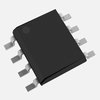-
A good PCB layout for the MAX998ESA+ involves keeping the input and output traces separate, using a solid ground plane, and placing the device close to the power source. Additionally, using a shielded inductor and keeping the switching node (SW) away from sensitive nodes can help minimize EMI.
-
To optimize the compensation network, start with the recommended values in the datasheet and then adjust the resistors and capacitors based on the specific application requirements. Use a network analyzer or simulation tools to fine-tune the compensation network for optimal stability and transient response.
-
The MAX998ESA+ can handle input voltages up to 28V, but it's recommended to operate within the specified input voltage range (4.5V to 24V) for optimal performance and reliability.
-
The MAX998ESA+ is rated for operation up to 125°C, but it's essential to consider the thermal design and heat dissipation in high-temperature environments to ensure reliable operation.
-
To ensure the MAX998ESA+ meets the required efficiency standards, optimize the design for minimal power losses, use a high-efficiency inductor, and consider using a synchronous rectifier. Additionally, follow the recommended layout and component selection guidelines in the datasheet.
 MAX998ESA+ datasheet
by Maxim Integrated Products
MAX998ESA+ datasheet
by Maxim Integrated Products